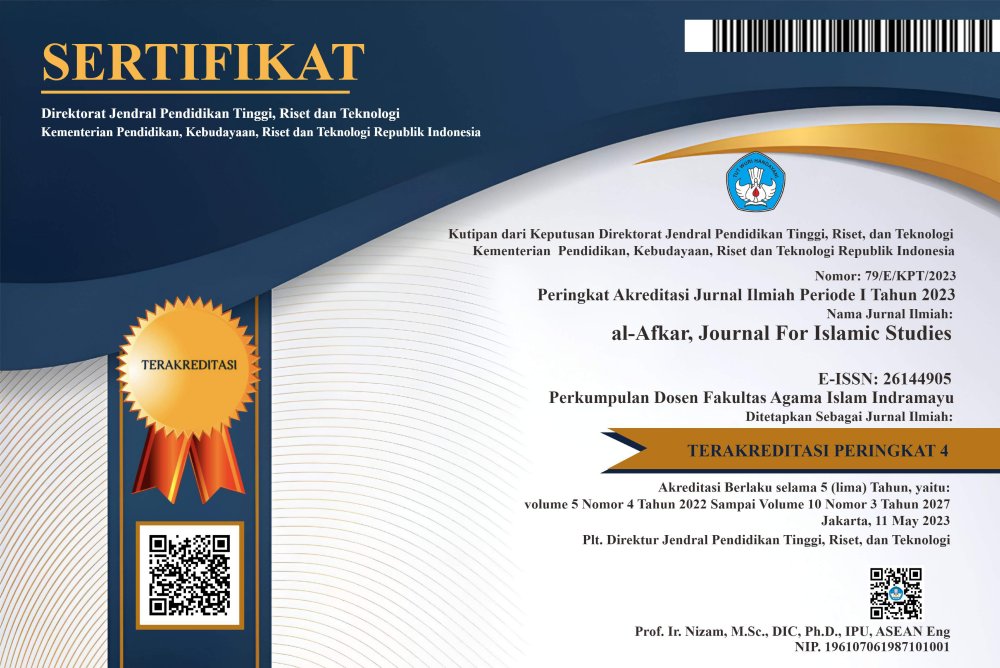Popular Hadiths of the Tablighi Jamaat Community (Reinterpretation Using a Historical-Contextual Approach)
DOI:
https://doi.org/10.31943/afkarjournal.v7i1.918Keywords:
Hadith, Tablighi Jamaat, Historical-Contextual.Abstract
This study discusses the traditions that are popular among the Tabligh Jamaah, focusing on three traditions; namely, the hadith about shaving the mustache and maintaining the beard, the hadith about wearing a white robe, and the hadith about using siwak. This research is a literature research, using a historical-contextual approach. The results of this study conclude that the traditions studied using the historical-contextual approach produce a new understanding that tends to be contradictory compared to the textual reading. The historical-contextual approach is able to present a more complex reading of the hadith, opening up the potential of Muslims to innovate with something more useful, as well as emphasizing the dividing line to distinguish between Islamic doctrine and the culture of Arab society which is the background of the decline and development of Islam.
Downloads
References
al Hasin, I. H. (n.d.). Al Bayan Wa Al Ta’rif Fi Asbab Al Wurud Al Hadith Al Sharif (Vol. 2). Maktabah Misri.
al-Qardhawi, Y. (1992). Kaifa Nata’mal Ma’a al-Sunnah al-Nabawiyyah. Dar al-Wafa.
Alimuddin, T. (2008). Kumpulan Hukum dan Fadhilah Janggut, Rambut, Peci, Sorban, Gamis, dan Siwak Menurut Al-Qur’an dan Hadis. Pustaka Ramadhan.
Dedi Mulyana. (2004). Metodologi Penelitian Kualitatif. PT. Remaja Rosda Karya.
Didi, J. (n.d.). Memahami Teks, Melahirkan Konteks: Menelisik Interpretasi Ideologis Jamaah Tabligh. Jurnal of Qur’an and Hadith Studies, 2(1), 2013.
Faiqoh. (1998). Nyai sebagai Agen Perubahan: Tantangan bagi Nyai-Nyai Generasi Mendatang (Studi Kasus Pada Pesantren Maslakul Huda, Pati Jawa Tengah). Universitas Indonesia.
Fauzi, A. N., Latifah, S. N. A., & Nasrulloh, N. (2023). PEREMPUAN SEBAGAI PEMIMPIN PADA RANAH PUBLIK (Dalam tinjauan metode memahami hadis tekstual dan kontekstual Syuhudi Ismail). EGALITA, 18(2). https://doi.org/10.18860/EGALITA.V18I2.21658
Hallberg, L. R. (2009). The “ core category ” of grounded theory: Making constant comparisons. International Journal of Qualitative Studies on Health and Well-Being, 2631. https://doi.org/10.1080/17482620600858399
Haryanto, Sri. (2017). Pendekatan Historis Dalam Studi Islam. Manarul Qur’an: Jurnal Ilmiah Studi Islam, Volume. 17.
HIdayat, K. (1996). Komaruddin Hidayat, Memahami Bahasa Agama: Sebuah Kajian hermeneutik. Paramadina.
Hitti, P. K. (2002). History of the Arab: Rujukan induk dan paling otoritatif tentang sejarah peradaban Islam (C. L. Yasin & D. S. Riyadi, Trans.). Zaman.
Ikbar, Febri Nurrahmi, & Syam, H. M. (n.d.). Kohesivitas Pada Kelompok Jamaah Tabligh. Jurnal Komunikasi Global, 8(2), 2019.
Ismail, S. (1994). Hadis Nabi yang Tekstual dan Kontekstual. Bulan Bintang.
Khummaini, Y., & Mamun, S. (2020). Jodoh dan Perjodohan Santri Jamaah Tabligh di Pesantren Temboro. Ulul Albab: Jurnal Studi Dan Penelitian Hukum Islam, 3(1), 23. https://doi.org/10.30659/jua.v3i1.7586
Mohd Ghazali, N., Abd Manan, M., Mohamed Nor, Z., Adawiyah Mohd, R., Ahmad, N., & Pengajian Al-Quran dan Sunnah, F. (2023). Analisis Makna Kontekstual Hadis Peranan Ibu Terhadap Pembentukan Spiritual Anak Berdasarkan Hadis Sahih Al-Bukhari. Journal Of Hadith Studies, 8(2), 46–58. https://doi.org/10.33102/JOHS.V8I2.244
Nur’aini, S., & Naskah, H. (2023). Pemikiran Syuhudi Ismail tentang Hadis Tekstual dan Kontekstual. Cendekia Inovatif Dan Berbudaya, 1(1), 1–6. https://doi.org/10.59996/CENDIB.V1I1.145
Qurni, W. al. (2023). Metodologi Dalam Memahami Hadis (Tekstual, Kontekstual, Liberal). Innovative: Journal Of Social Science Research, 3(4), 1885–1898. https://doi.org/10.31004/INNOVATIVE.V3I4.3685
Rasminto. (2010). Paradigma Pendidikan dan Dakwah Jamaah Tabligh. UIN Maliki Press.
Rizqi, M. (2018). Kontekstualisasi Pemahaman Hadis, dalam. Kontekstualisasi Pemahaman Hadis. https://surauparabek.or.id/muhammad-rizqi/kontekstualisasi-pemahaman-hadis/
Saepuloh, U. (2009). Model Komunikasi Dakwah Jamaah Tabligh. Ilmu Dakwah: Academic Journal for Homiletic Studies, 4(14), 657–688. https://doi.org/10.15575/idajhs.v4i14.416
Shahab, A. N. M. I. (2007). Khuruj fi Sabilillah: Sarana Tarbiyah Umat untuk Membentuk Sifat Imaniyah. Pustaka Ramadhan.
Zaki, M. (2015). Metode Pemahaman Dan Pengamalan Hadis Jamaah Tabligh. Jurnal Pengembangan Masyarakat Islam, 8(2).
Downloads
Published
How to Cite
Issue
Section
License
Copyright (c) 2024 Muhammad Irsad

This work is licensed under a Creative Commons Attribution 4.0 International License.



















